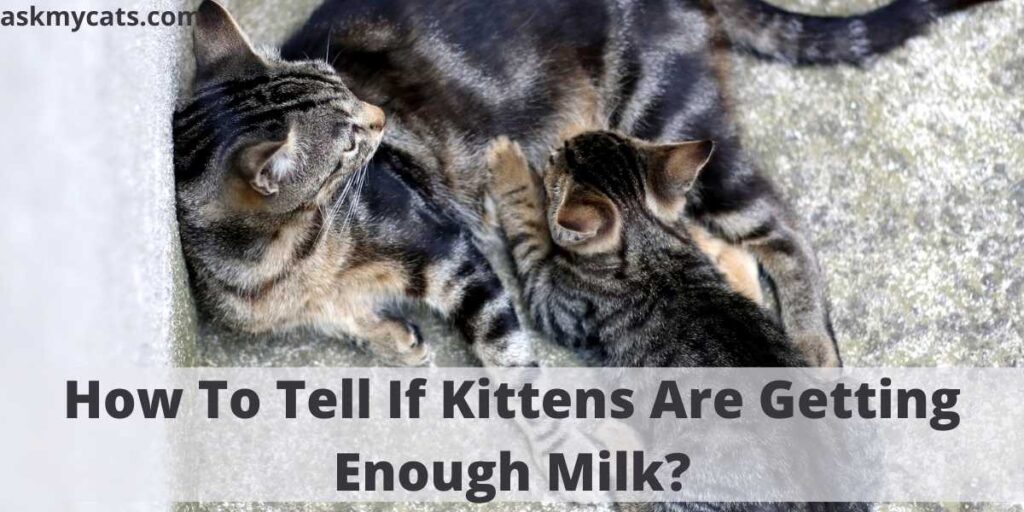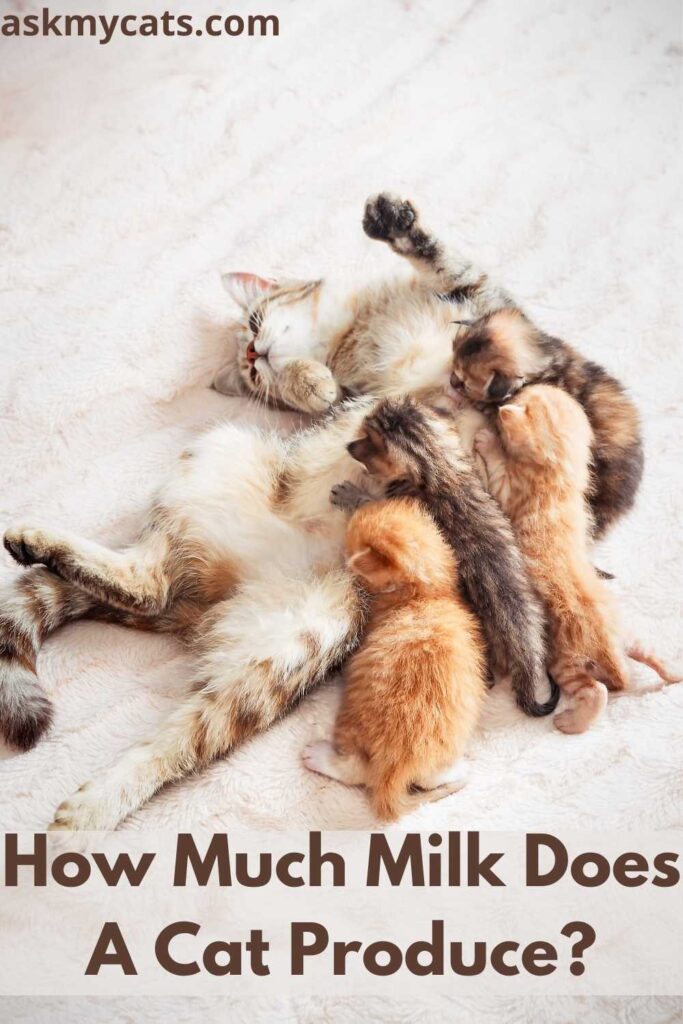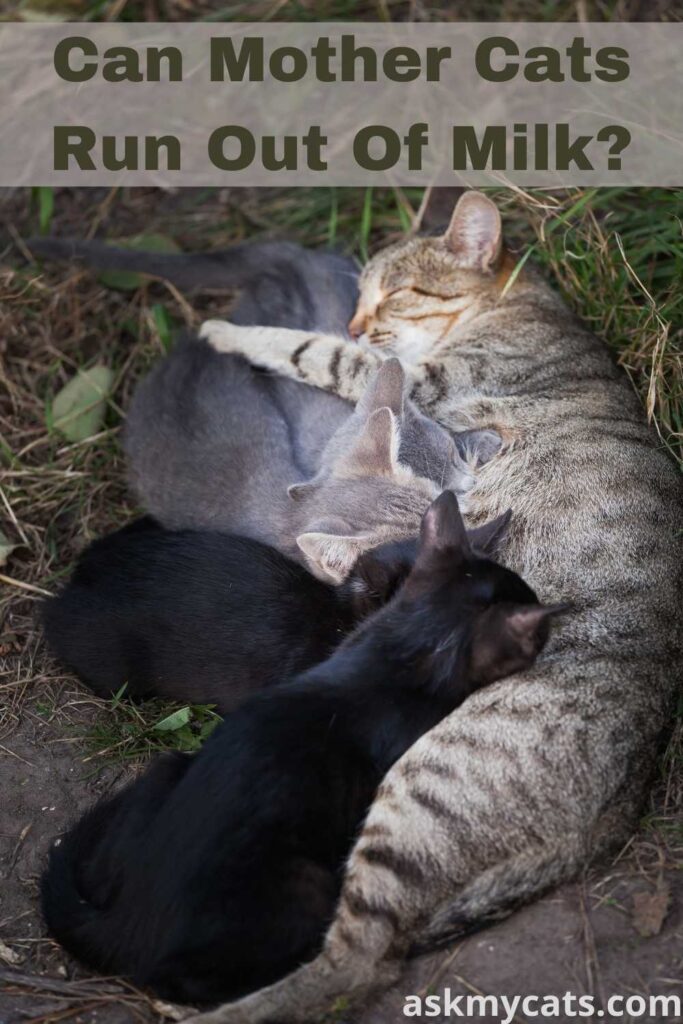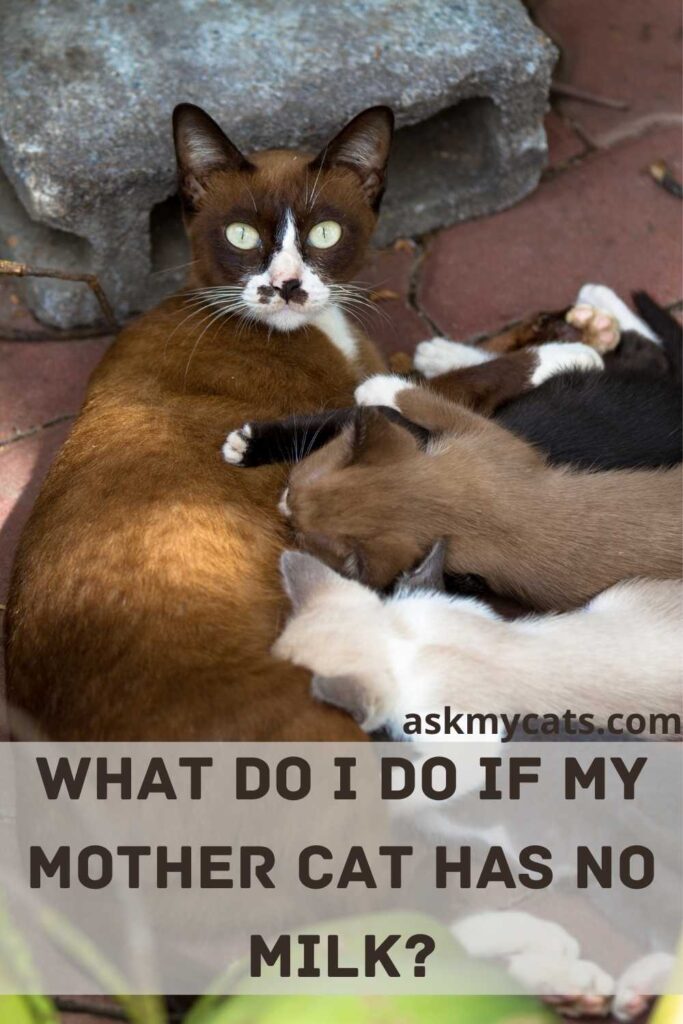If you have a female cat who has recently given birth, you will be responsible for caring for and monitoring the newborn kittens.
While the mother will feed the kittens and keep them safe and warm, you will need to provide them with a dark, safe, and quiet environment in which to grow.
You must closely monitor the newborns during the first 10 weeks of their development to ensure their health, and you must take them to the veterinarian if any medical problems arise.
So, how to tell if kittens are getting enough milk?
You can tell if kittens are getting enough milk by closely monitoring them. Newborns spend long hours nursing – up to 8 hours per day – with sessions lasting up to 45 minutes.
This article will inform you how you can tell if kittens are getting enough milk.


Give Your Cat the Perfect Day
Get the Free Ebook!
How Much Milk Does A Cat Produce?
In a study by Nutrition for Health, the average cat produces 4.14% of its body weight. There is a close relationship between milk yield, litter size, and lactation stage.

Cats can become pregnant before the age of a year and remain pregnant for about two months.
When they are about to give birth, lactation will begin.
Cats typically have eight teats, all of which produce milk.
Cats that are not pregnant, and sometimes even those that have been spayed, can produce milk, which is known as a false or pseudopregnancy.
Hormones in a cat’s body regulate this unnecessary milk production.
If your cat is not pregnant but is lactating, do not allow it to nurse on items such as toys or socks, as this will prolong the false pregnancy.
Pregnant cats’ teats will swell about halfway through pregnancy, but they will not start lactating until a few days before giving birth.
During pregnancy, their appetite will increase to help provide the extra nutrition that their bodies require to produce milk.
When they give birth, the kittens will require the first milk produced by the mother cat, known as colostrum.
Colostrum is high in nutrients and antibodies, which help kittens’ developing immune systems.
After about a month of nursing, the kittens will begin to wean themselves from their mother.
While the kittens are still nursing from their mother, liquefied kitten food should be freely offered to them.
Over the next 6 weeks, the kittens will gradually eat more kitten food and nurse less.
During the weaning period, the kitten food will progress from a liquid to a watered-down canned food, then to regular canned food, then moistened kitten kibble, and finally hard kibble until it is ready to leave its mother at 12 weeks of age.
If a kitten is eating on its own, you should limit the amount of time it needs to nurse. If a kitten is eating well on its own but still wants to nurse frequently, you will need to limit the kitten’s access to its mother for a portion of the day.
Adequate nutrition is required for a cat to produce enough milk for all of its kittens.
Cats typically have about five kittens per litter, but if the litter is unusually large, the cat may require supplemental nutrition to help its body produce enough milk for its young, or the kittens may require supplementation if they aren’t getting enough feeding time with so many litter mates.
To accommodate the additional stress of feeding kittens and the energy requirements of lactation, nursing cats should be fed kitten or growth diets high in calories, fat, and calcium.
If you are concerned about a mother cat’s nutritional needs, talk to your veterinarian about what you can do.
The mother cat is at its most stressful and demanding point of lactation during weeks three or four of nursing.
The mother cat’s body has been continuously producing milk for about a month, but it is about to slow down.
Because the kittens are weaning off their mother’s milk at this point, less milk will be required.
When kittens start eating solid food, they usually don’t try to nurse, so the mother cat’s milk production drops dramatically.
After a few weeks, the milk should be completely dry, but this is a slow process. The teats will remain swollen and produce milk at first.
The milk will then stop coming, the swelling will subside, and the mammary glands should no longer be swollen under the teats after one to two weeks.
Check out How To Make A Cat Produce Milk?
Can Mother Cats Run Out Of Milk?
Yes, mother cats can run out of milk.

A mother cat takes care of her newborn kittens. Without the assistance of their mother, a newborn cannot regulate their temperature, see, hear, or even defecate.
Importantly, neither of them can feed. Female cats are mammals due to the presence of mammary glands.
These glands enable them to feed their young with the breast milk that they produce.
This breast milk is more than just food.
The first milk, known as colostrum, that cats give to their kittens is rich in essential nutrients that help to strengthen the vulnerable young cat’s immune system. The milk will gradually change, but it will still be nutrient-dense.
If a mother cat does not produce milk, the kittens are in grave danger. Their ability to survive is jeopardized.
You would also like to check how long can a kitten go without eating
It is normal for a cat to produce milk for their young. The cat’s breasts prepare for future milk production during pregnancy.
The glands enlarge and begin to produce colostrum immediately after birth. This cat’s first milk is highly nutritious and serves an important immunological function.
Kittens are vulnerable at birth and require protection from bacteria, viruses, and anything else that can compromise their immune system.
This is one of the reasons cats nest before giving birth. They must safeguard their newborns.
Regular cat milk is produced after the colostrum. The milk is secreted from the cat’s breasts via the nipples.
The kittens will latch on with their mouths and knead the breast with their paws as they grow.
This is done to encourage lactation (milk production). This also aids in the kittens’ bonding with their mother.
You might be able to see the milk being secreted or simply see it around the kittens’ mouths at times.
This, however, will not always be the case. Still, if the kittens are nuzzling up to their mother’s belly and sucking on her nipples, milk is being produced.
Kittens intuitively understand how to suck. They will spend most of their time suckling or sleeping.
When the mother’s lactation is normal, the kittens are quiet and sedate. They are well-fed, and their mother takes care of their other needs.
It should not be necessary to manipulate the mother’s breasts in order to force secretion.
Although extremely unlikely, it is possible that a mother cat does not have enough milk for her kittens.
If you’re wondering how we can tell if a cat isn’t producing milk, look at the kittens’ health. The absence of the idyllic scene of well-fed young would be a clear warning sign.
The kittens, on the other hand, will be moaning and looking for food. They’ll be clambering over each other, sucking at their mother with no success.
Well-fed kittens will gain visible belly fat as a result of their feeding. This will not happen if they haven’t eaten.
Kittens that are unable to feed will quickly become dehydrated, cold, restless, and more vulnerable to disease.
The kittens will perish if we do not act quickly. The first step is to take them to a veterinarian.
They will be able to confirm that the problem is due to a lack of milk production rather than another pathology. If necessary, they will also be able to provide emergency nutrition and fluid therapy.
The reasons why a cat is not producing milk are hard to determine. They could be due to:
- Genetics: It is possible that the cat will have a genetic problem that prevents them from producing milk. Because there is nothing that can be done to resolve this issue, the cats will have to be artificially fed instead. The mother may be unaware that she is unable to breastfeed.
- Malnutrition: When a mother cat is getting ready to give birth, she will eat regularly and prepare her body. She may stop eating just before delivery, but this is due to the need to nest and prepare. However, if she is not given enough food or is unable to eat for any reason (e.g., a sore tooth, throat problems, etc.), she may be unable to produce enough milk. Even if she is able to produce some, it may not be sufficient for the kittens’ nutritional needs.
- Infection: If a mother cat has a bacterial or viral infection, it can affect her breasts. Mastitis is an inflammation of the cat’s breasts. Breasts that are swollen may be unable to produce milk. However, a severe infection would be required to prevent all of the nipples from producing milk. The kittens should not try to feed whether the cat produces no or some milk. The infection could be passed on and harm them, especially given their vulnerable state.
- Other diseases: Other diseases may be preventing the cat from lactating. This includes issues such as breast cancer, but the extent of the damage will depend on how far the disease has progressed.
- Stress: A stressed-out cat may be unable to secrete milk. This is due to the kittens’ kneading and suckling, which produces the hormone oxytocin. Oxytocin, also known as the “happiness hormone,” is required for milk release. If the cat is overly stressed, a lack of oxytocin can result in an inability to feed.
Recognizing the signs that a cat is not producing milk is critical. You must act quickly or the kittens will become malnourished and die if no action is taken.
You might also like to check out how to bottle feed a kitten that won't eat
What Do I Do If My Mother Cat Has No Milk?
If your mother cat has no milk you must take her to the vet as soon as possible.

If you have a pregnant cat, you must do everything you can to assist them in preparing.
This includes providing them with comfortable places to rest, adequate high-quality food, and sanitary living conditions to keep them disease-free.
When the time comes, a healthy cat should be able to produce milk.
If they can’t, our first thought might be to find a way to increase milk production.
Unfortunately, there is no quick fix or miraculous food that will cause the mother cat to begin producing milk.
If an illness or disease causes the condition, it must be treated. This is time-consuming, which the kittens will not have much of.
If the problem is genetic, no matter how hard we try, they may never be able to produce milk.
By providing a calming environment and reducing any stressors, we may be able to soothe the cat. However, it is much easier to say than it is to do.
There is just one viable alternative for a mother cat who is unable to produce milk. You’ll have to feed the kittens artificially.
You would like to check what to feed a baby kitten if you don't have formula
Frequently Asked Questions
How to artificially feed kittens?
The veterinarian will be able to advise you on how to feed the kittens artificially. If the kittens haven’t had any milk, they’ll require artificial colostrum to strengthen their immune systems. They can then be fed fake kitten milk after they’ve been given this. You should always follow the directions on a product, but you should also ask your veterinarian for a recommendation for a high-quality brand that is available in your area. You need to monitor the temperature before giving the kittens the artificial formula. The kittens may not be able to feed if the milk is excessively hot or cold. Initially, kittens will need to be fed every 2 hours or so. Other forms of milk should not be used since they may not be able to offer the nutrition that the kittens require.
How to make sure the kittens are eating?
The mother’s milk provides all of the nutrients that kittens require to develop and thrive, as well as keeping them hydrated. Your involvement will be limited at this time as long as the kittens are breastfeeding on a regular basis. During the first two weeks, the mother cat will start feeding the kittens, and they should have big, plump stomachs after nursing. The kittens aren’t getting enough nutrients if they aren’t nursing every 1–2 hours. This condition might also be indicated by a lack of sleep and persistent sobbing. Keep an eye on a kitten for a couple of days if it isn’t feeding regularly or doesn’t appear to be content or plump. If the kitten’s condition does not improve, you should contact your veterinarian for advice; you may need to bring the kitten in to see them.
What to do with sick or deformed kittens?
One or more kittens may have a health problem that the mother cat detects or suspects, and the mother cat may refuse to nurse that kitten. In an instinctive attempt to safeguard the other kittens, she may remove the sick kitten from the nesting box. The issue could be a visible congenital anomaly, a serious sickness, or something more subtle. Returning a rejected kitten to the nesting box is unlikely to succeed, and it may further stress the mother. Instead, talk to your veterinarian about how to bottle-feed and keep the rejected kitten warm while you schedule an appointment with your veterinarian.
Final Words
If you notice that the kittens are not getting enough milk, you must contact your vet as soon as possible as this can result in them being malnourished, dehydrated or even die.
If you have any questions, ask us in the comments section.
